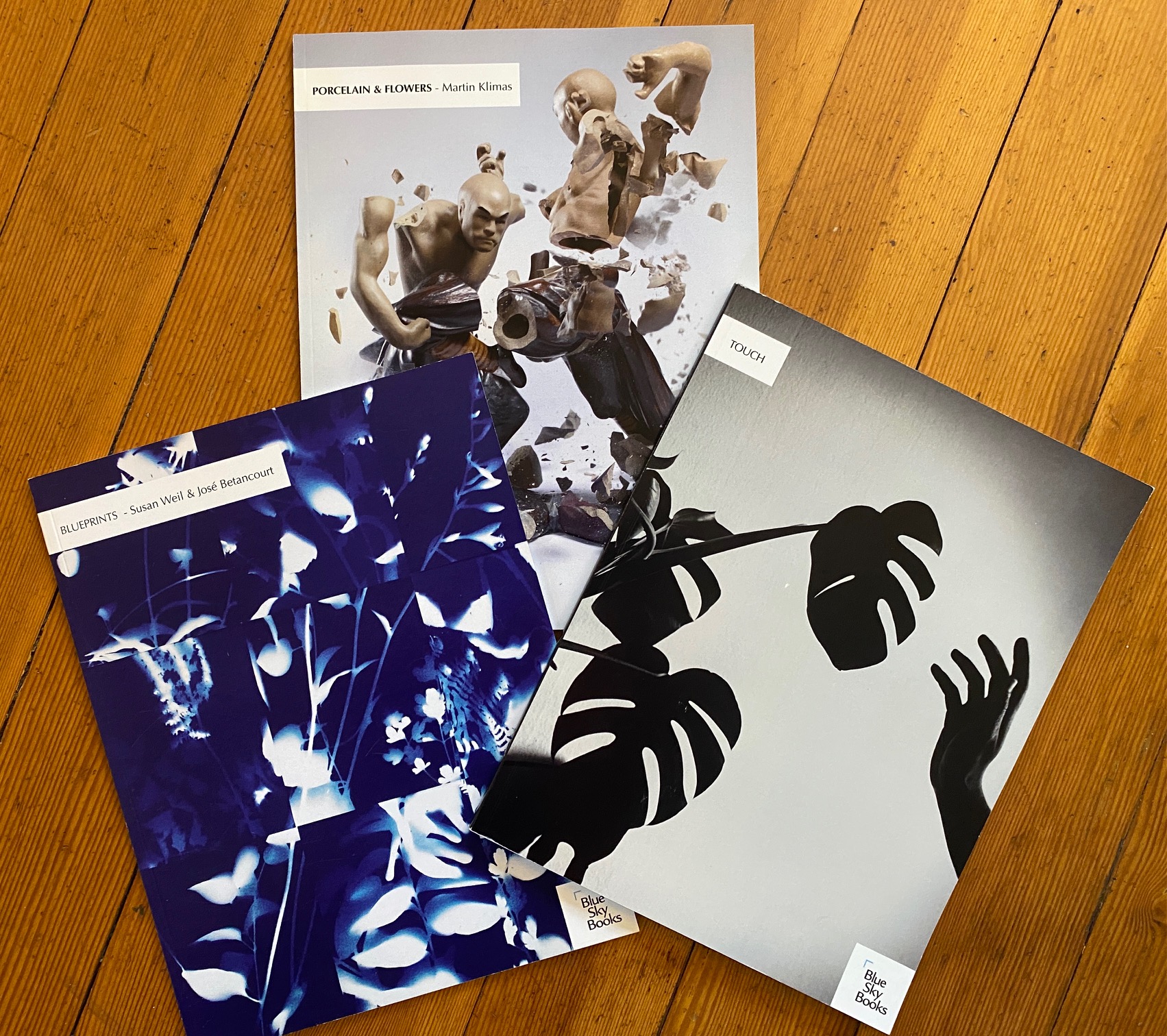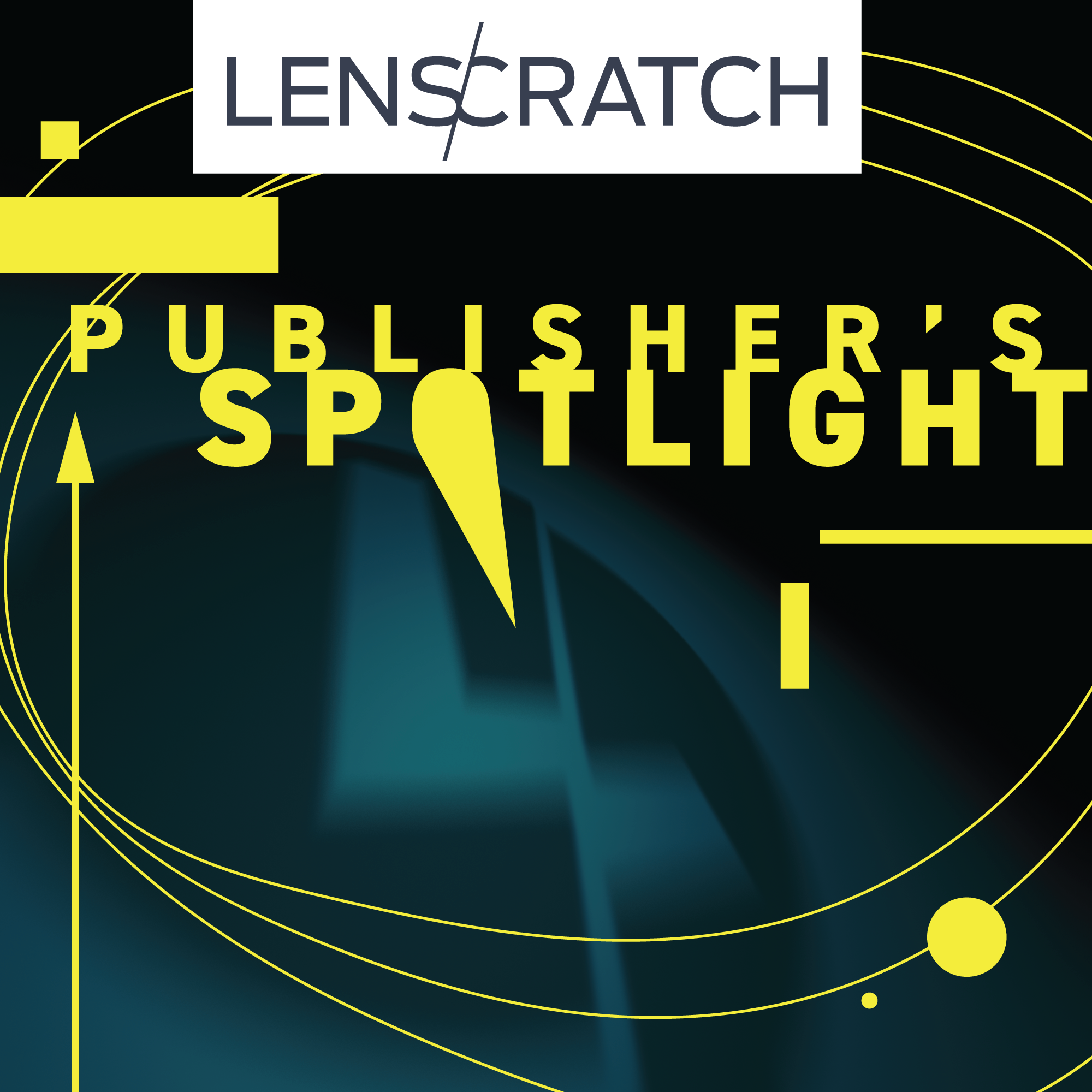Publisher’s Spotlight: Blue Sky Press

Porcelain & Flowers by Matin Klimas, Blueprints by Susan Weil and Jose Betancourt, and Touch, Blue Sky Books
These past months we have been focusing on books on Lenscratch. In order to understand the contemporary photo book landscape, we are interviewing and celebrating significant photography book publishers, large and small, who are elevating photographs on the page through design and unique presentation. We are so grateful for the time and energies these publishers have extended to share their perspectives, missions, and most importantly, their books.
Founded as the Oregon Center for the Photographic Arts by a group of five young photographers in 1975, Blue Sky quickly established itself as an important venue for local photography. In a short period of time, the organization expanded its offerings to include national and international artists, many of whom exhibited at Blue Sky early in their careers.
Blue Sky’s special endeavor continues to be solo exhibitions and publications of emerging and established artists that exemplify the finest in photographic vision and innovation. As such, Blue Sky has earned the accolade as having “the best record of discovering new photographers of any artists’ space in the country.”
Today, from its 3,700-square-foot facility in Portland’s historic DeSoto Building, Blue Sky presents over 20 exhibitions annually, maintains a public research library, showcases regional photographers in an annual juried exhibition of original works in its Pacific Northwest Photography Drawers, and offers artist talks and programs — all free to the public.
Aline Smithson is in conversation with photographic artist and co-founder and Board Chairman of Blue Sky Gallery, Christopher Rauschenberg.
Follow Blue Sky Gallery on Instagram: @blueskygallerypdx

What was the first book you published, and what did you learn from that experience?
The first book I published was Drugstore Photographs, published in 1976 in conjunction with a show of snapshots at Blue Sky Gallery. It is a 5.25 x 7.25” saddle-bound (staples, like a comic book) book of 66 snapshots from Terry Toedtemeier’s and my collections. It sold for $2.95 (a dollar more than The Animals by Garry Winogrand!). My steep learning curve came before that though, in the course of supervising the printing of our monthly exhibition posters.
What is your mission as a publisher?
Blue Sky’s mission is to educate the public about photography through exhibitions, publications, and dialogue; and to further the careers and artistic development of the artists shown.
Our core values are: EXCELLENCE, in artistic practice, in nonprofit administration, and in the production of exhibitions and publications; INTEGRITY, in transparent operations, in community relations, and in the creative endeavor; and RESPECT, for the history of photography, for Blue Sky’s longevity and collaborative traditions, and for the diverse community of individuals who support and are represented by the organization.
We are proud never to charge admission to the gallery, to provide honoraria and royalties to our artists, and to sell our Blue Sky Books for good low prices. (The books vary from 30 to 160 pages and cost from $9 to $43, with the average book at 66 pages for $19.)
Photography’s power to show the world through someone else’s eyes comes with great responsibility. Blue Sky is committed to advancing a more just and equal world to positively impact our artists, staff, board, volunteers, members, visitors, and community. With our dedication to bringing forth visual stories from a range of voices, we recognize we can all learn from the richness of diverse perspectives and histories. As an organization, we examine all our policies through an equity lens, find ways to be more responsive, and continually pursue ways to maximize inclusion.
How big is your organization?
Over its 46 year history, Blue Sky Gallery has expanded from zero to three FTE staff, with a volunteer exhibition committee of about 20 people. The Blue Sky Books program runs on zero staff, with the basic book design done by Ben Hickman and the 123 book layouts done by Blue Sky co-founders and Board members Craig Hickman and Christopher Rauschenberg.
What are the difficulties that publishers face?
For most publishers the two big problems are money and distribution. We do our Blue Sky Books at no cost to anyone so that just leaves us with our biggest problem, distribution.

Drawn to Water by Christine Osinski, House/Hold by Hillerbrand+Magsamen, and Private Fears by Carl Bower
Are there any publishing projects that have been particularly meaningful to you?
So many… I’m deeply moved by Carl Bower’s Private Fears (published in November), which combines great portraits with powerful writing by the subjects about their deepest fears. One of the first books in the series was Work From Two Bodies by Karl Baden, which combines great proto-photoshop work that we exhibited in 1985 (Cliché-verre and Shadow Pictures) and 1989 (Sex, Death and the History of Photography). These works weren’t available anywhere else, in print or digitally, and Karl had to make new prints to be able to do the book. I felt proud to have this book (one of our best sellers) preserve this important work’s place in history. I was honored to have been able to produce definitive retrospective monographs by master photographers Harold Feinstein and Oscar Pintor. So many….
What upcoming projects are you excited about?
We are currently excitedly awaiting delivery of Dear Friend by Kensuke Koike, who is showing absolutely brilliant single image collages at Blue Sky in January.

The Soft Fence by Gioncarlo Valentine, Creating A Family by Edis Jurcys, and Soldier and Citizen by Suzanne Opton, Blue Sky Books
How many books do you publish a year, and how do you choose which projects to publish? Do you have a specific focus?
We’ve published 123 books in this series in the last seven years, which works out to seventeen and a half per year. All of the books correspond to shows that we have had at Blue Sky over our 46 year history.
How can an artist get their work in front of you? Do you have any advice for photographers?
Photographers are always invited to submit show proposals through our website (blueskygallery.org/submissions). We project and discuss every proposal. Every artist who is given a show is also offered the chance to make a Blue Sky Book. The strongest proposals will bring together 20-30 images from one series. Blue Sky exhibition committee members have also reviewed portfolios at 18 festivals in 10 countries.
What is the typical timeline of a project, from the beginning to the finished product?
Two weeks to a month.
How collaborative is the design process with the artist?
The design process is actually not very collaborative. We have a basic design for the series which is modified sometimes, where possible, to match design requests from the artist. Our design puts each image on its own page without bleeding them (except on the covers) or running them through the gutter. Deciding which works to include and sequencing them are done by the artists.
How is the financial side of the project structured between publisher and artist? Does the artist contribute to production cost?
Neither the artist or the gallery incurs any cost at all, except for purchasing books as they are wanted. All sales are handled by MagCloud and royalties of 15% are offered to the artists once per year. (So far, those royalties have added up to over $7800.)
What support do you give artists in terms of marketing or distribution? Do you attend book fairs?
We don’t do much in the way of marketing and distribution. We don’t attend book fairs. We have used social media without much success and we are currently pretty much just putting the books out there and hoping that people find them. (We have sold 4500 books so far, so that’s not quite as pathetic as it sounds.) The books are only available at Blue Sky or through MagCloud. They range from 30 to 160 pages and cost from $9 to $43, with the average book at 66 pages for $19. For each book, a full preview is available so that you can look at every image in the book as you consider buying it. As a photobook collector myself, I am often frustrated by being asked to buy a photobook based on just a photo of its cover or, only slightly better, just 3 or 4 images from the book. If any of you out there have any ideas to help us distribute the books, I’d love to hear from you at rberg@hevanet.com.
I am terrified that my genetics will someday be my future. Afraid of the voices in my head or that those bits of paranoia aren’t acceptable and in fact are the result of a disorder. My grandmother was schizophrenic and killed herself when I was six months old. I’ve lived with her shadow. My dad always warning “that stuff skips a generation,” and it’s terrified me since childhood as I’ve struggled through my own bouts of mental health issues.
Christopher Rauschenberg has had 124 solo shows in eight countries on three continents. He is a co-founder and Board Chairman of Blue Sky Gallery (www.BlueSkyGallery.org) wherever the last 46 years, he has co-curated 900 solo shows by 767 artists, along with 56 group shows.
In 1995, he organized a group of a dozen artists who joined him in a nine year long systematic photographic exploration and documentation of the city of Portland. (www.PortlandGridProject.com) The third round has recently been completed..
In 1997 and 1998, he took three trips to Paris and rephotographed 500 of the images made of that city by Eugene Atget between 1890 and 1927. (LensCulture interview)
He is a co-founder and past president of Photolucida (a Portland photography festival formerly called Photo Americas) (www.photolucida.org).He shows regularly at Elizabeth Leach Gallery and the co-op Nine Gallery, both in Portland.
His work is held in the collections of 13 major museums.
Posts on Lenscratch may not be reproduced without the permission of the Lenscratch staff and the photographer.
Recommended
-
Aaron Rothman: The SierraDecember 18th, 2025
-
Photographers on Photographers: Congyu Liu in Conversation with Vân-Nhi NguyễnDecember 8th, 2025
-
Linda Foard Roberts: LamentNovember 25th, 2025
-
Arnold Newman Prize: C. Rose Smith: Scenes of Self: Redressing PatriarchyNovember 24th, 2025
-
Spotlight on the Photographic Arts Council Los AngelesNovember 23rd, 2025
























































